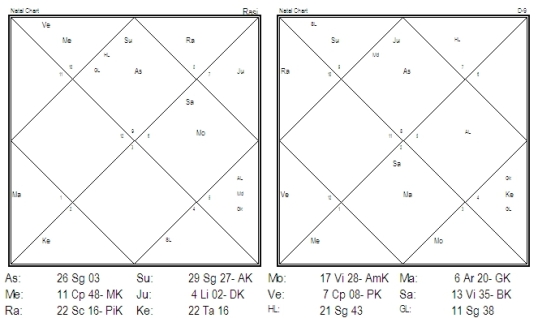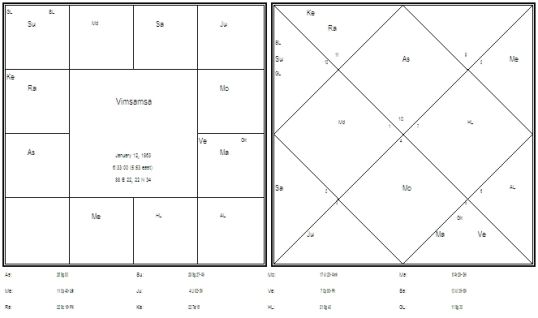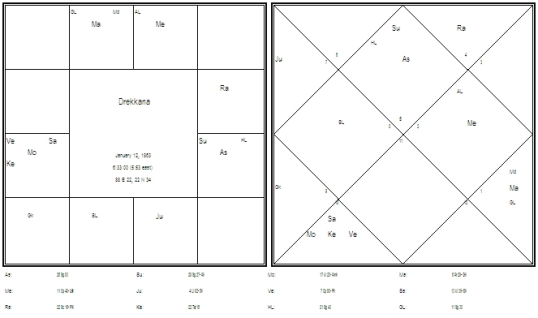Important yogas in charts of Spiritualists Part – 03
Gouri-yoga: Gouri is another name for goddess Parvati, the consort of Lord Siva, and thus Gouri-yoga is very auspicious. If the Navamsa dispositor of the lord of the 10th house is exalted and joins the lord of the Lagna in the 10th house (in Rasi or Navamsa charts) then Gouri-yoga is formed. Let’s just say that one who receives the blessings of Gouri is quite pious and has accumulated much in the way of sukriti or the good results of sadhana and other types of auspicious activities through the prior lifetimes. While Lakshmi-yoga directly brings the blessings of the goddess through the 9th house, Gouri-yoga similarly brings the blessings of dharma through the Navamsa chart to the 10th house (karmas). The yoga is somewhat rare in that the Navamsa dispositor of the 10th lord has to be exalted and must join the Lagna lord in the 10th house. The latter raja-yoga, in itself, is not frequently found.
Sankha-yoga: Sankha-yoga forms when the lord of the 5th house conjoins or mutually aspects the lord of the 6th, while the Lagna lord is simultaneously strong. The effects are powerful on the level of raja-yoga, and thus are significant when the yoga is found in the chart of a serious spiritualist. This is because the house of sadhana, the 5th house, joins the house of seva, the 6th house. Interestingly enough, this yoga is found frequently in the charts of bhakti-yogis as well as others who revere the personal forms of God or deity. Sankha-yoga is especially strong when lords of Kendras, especially the 1st and 10th, as well as the lord of the 9th, join the yoga. Sankha means “conch shell”, which is one of the four objects held in the hands of Lord Sri Vishnu.
Vishnu-yoga: The 9th lord, 10th lord and Navamsa dispositor of the 9th conjoin in 2nd house. The native is said to be fortunate, long-lived, favored by persons in positions of power and a devotee of Lord Vishnu. Note here, that the strength of the yoga forms due to the connection of the 9th lord and its Navamsa dispositor with 10th lord, and all of them join in the 2nd house.
Siva-yoga: The 5th lord is in the 9th; the 9th lord is in the 10th, while the 10th lord is in the 5th. Again the importance here is found due to the connection of lords of trikonas and the 10th house. In effect, the Siva-yoga is akin to the Dharma-karmadhipati-yoga as given above.
Except these Yogas and few others, Atmakaraka plays a very important role in deciding the renunciation in one’s chart.
According to Siva Purana, there are eight bonds or ropes holding the atma or soul. As long as they hold the atma, the atma is called jiva or living. Once the atma controls these chains it is called mukta, i.e. liberated. These eight chains symbolize the eight Chara karakas in jyotish.
Of the Chara karaka, the most important is the Atmakaraka which signifies the self or the soul in this world. Notably a proper term for this would be ‘spirit’ as it is bond between the atma and mana which brings the Chara Atmakaraka into existence for this life. By knowing the Graha indicated by the Chara Atmakaraka, we can understand the motivation that the native has for being in this world and its likes and dislikes. As per Maharshi Parashara, the Atmakaraka acts as the king of the chart and if the Atmakaraka favors the activity then it is sure to be accomplished, whereas if not then the accomplishment or even attainment is impossible. Also the likes and dislikes of an individual can be read from this and show whether a native favors or disfavors an activity.
The traits such as king, etc. can literally be applied to a mundane or Muhurta chart where the Atmakaraka will signify the ruler of the particular organization/ party or company, i.e. in a government it will indicate the ruling party and the presiding president or prime-minister of the country.
To know what the Atma favors or disfavors, we need to analyze the 1) Drsti 2) Kendra etc. placement 3) Sambandha of the Atmakaraka with other Graha or vice versa.
Of the three, the most detrimental towards progress is when the Atmakaraka is devoid of good Sambandha with another graham, bhava or Arudha. Bad Sambandha occurs when the graham, bhava or Arudha is either placed in Marana Karaka Sthana position, or inimical bhava based on Pachakadi Sambandha.
In addition to this, the twelfth house from the Atmakaraka shows the bondage and liberation of the Atma. Graha, bhava or Arudha placed here will if malefic be a cause of bondage on the Atma and the native will constantly feel bound by the activities associated with the same, believing that they are a cause of bondage in this life. If that Atmakaraka also happens to be inimical towards those Graha in the twelfth from Atmakaraka then the native will also reject the indications of the same.
Two more houses have to be mentioned in this regard, namely the sixth and eleventh houses from the Atmakaraka. As ones conscious experience of all events is seen from the fourth house, the third and eighth houses from it become the cause of terrible suffering and can lead to the native rejecting the indications of those Graha, bhava or Arudha after such incidents have shown up.
These principles come clearly to fore when analyzing the prevalence of other yoga in the chart, I.e. assume if a raja yoga occurs in a chart but is badly placed from the Atmakaraka, then in such a case the native, despite being presented with the opportunities for the same yoga, would shy away or avoid taking advantage of the raja yoga due to personal reasons associated with the Graha which is Atmakaraka.


